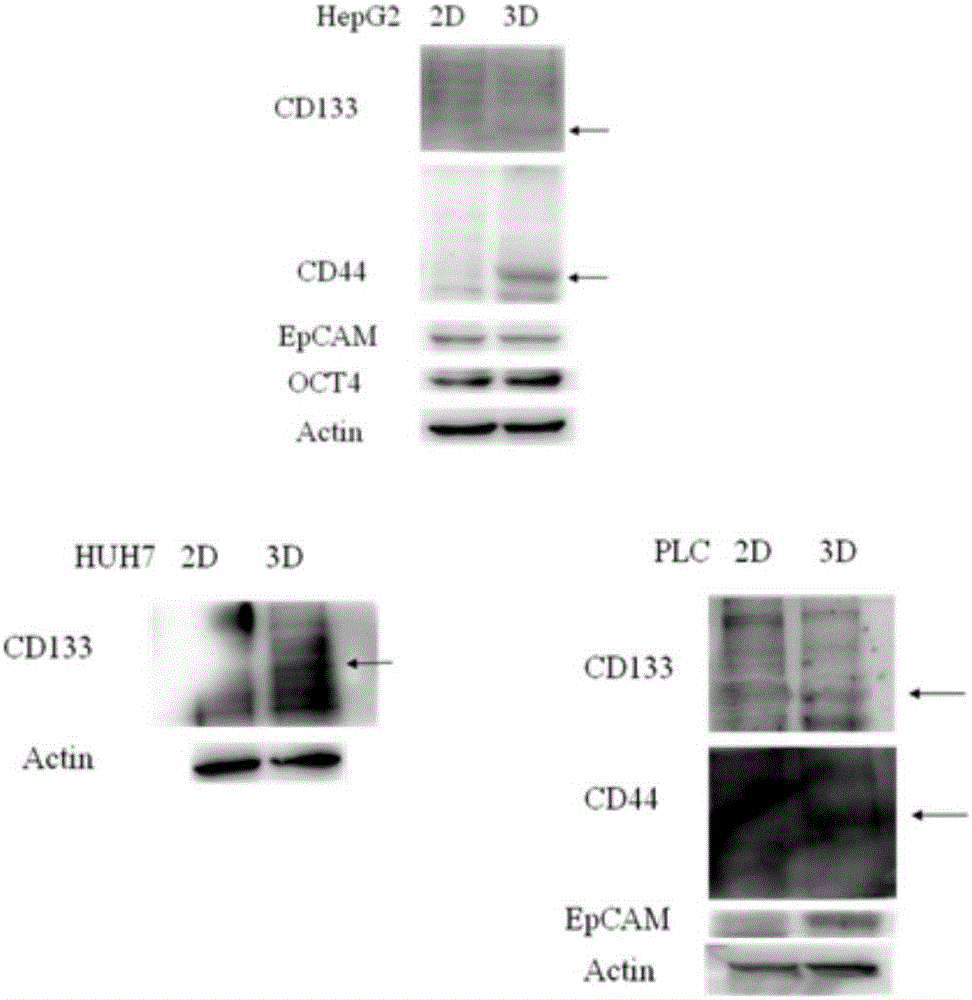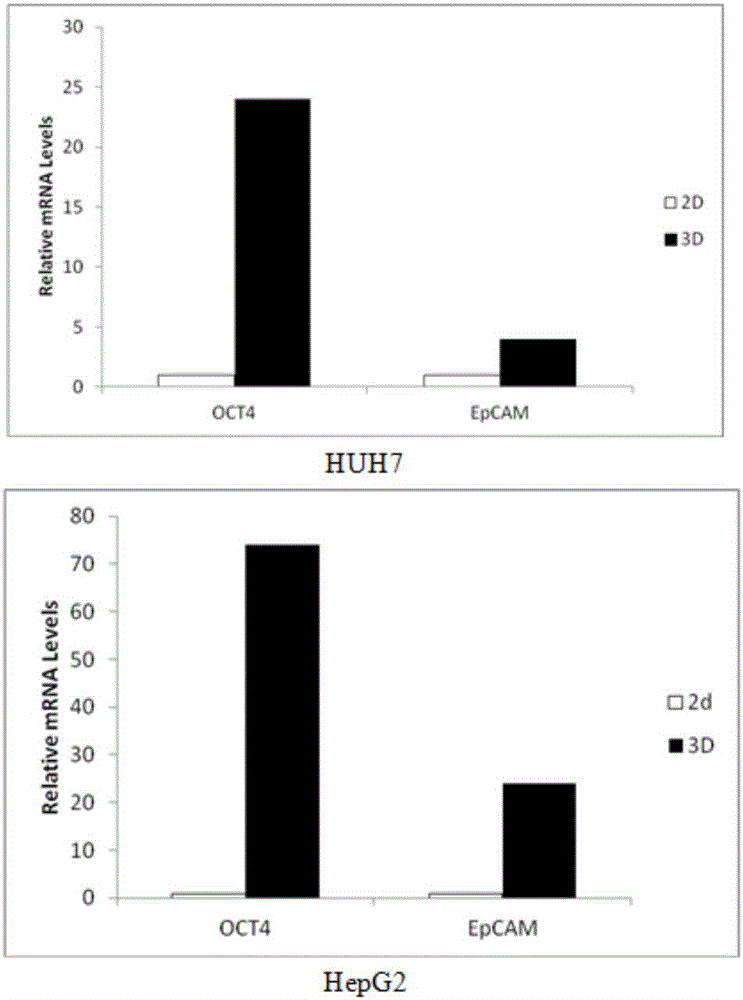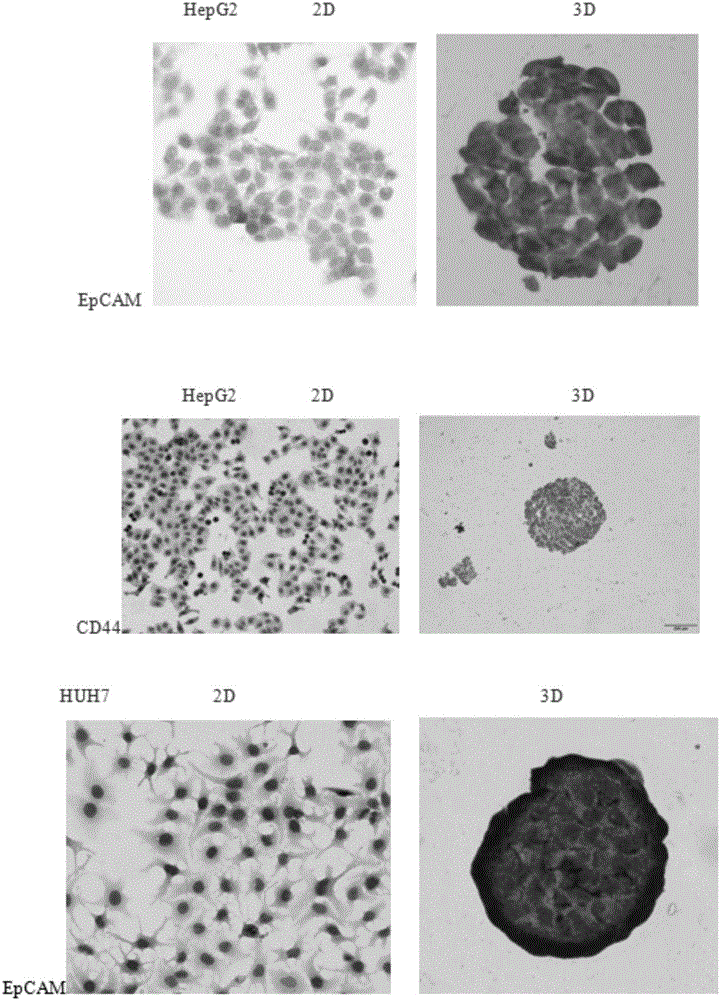Method for inducing liver cell cells to be transformed into liver cancer stem cells
A technology for liver cancer stem cells and liver cancer cells, which is applied in the field of inducing the transformation of liver cancer cells to liver cancer stem cells, can solve problems such as difficulty in studying the regulation mechanism of a single factor, and achieve the effects of good drug resistance characteristics, fast aging, and easy operation.
- Summary
- Abstract
- Description
- Claims
- Application Information
AI Technical Summary
Problems solved by technology
Method used
Image
Examples
Embodiment 1
[0040] Example 1: A method for inducing liver tumor cells to transform into tumor stem cells
[0041] 1) Digest hepatoma cells (HepG2, HUH7 and PLC / PRF / 5) in a good growth state and in the logarithmic growth phase with 0.25% trypsin, and digest them at 37°C for 5 minutes to obtain human hepatoma cells in a single-cell state, remove the After the digestion solution of trypsin, add it to DMEM complete medium containing 10% fetal bovine serum to make cell suspension;
[0042] 2) Spread an appropriate amount of cell suspension on a cell culture dish, place it at 37° C., 5% CO2, 20% oxygen content, and cultivate it in a cell incubator for 7 days, as a control for two-dimensional cultured cells. Replace the DMEM complete medium every other day; wherein, the DMEM complete medium is a high-sugar DMEM medium supplemented with 10% fetal bovine serum, 100 U / ml penicillin and 100 mg / ml streptomycin.
[0043] 3) 60 μl cell suspension (cell density is 10 5 Each / ml) was added dropwise on t...
Embodiment 2
[0045] Example 2 A method for inducing liver tumor cells to transform into tumor stem cells
[0046] 1) Digest hepatoma cells (HepG2, HUH7 and PLC / PRF / 5) in a good growth state and in the logarithmic growth phase with 0.25% trypsin, and digest them at 37°C for 5 minutes to obtain human hepatoma cells in a single-cell state, remove the After the digestion solution of trypsin, add it to DMEM complete medium containing 10% fetal bovine serum to make cell suspension;
[0047]2) Spread an appropriate amount of cell suspension on a cell culture dish, place it at 35° C., 5% CO2, 5% oxygen, and culture it in a cell incubator for 7 days, as a two-dimensional cell culture control. The DMEM complete medium was replaced every other day; wherein, the DMEM complete medium was a high-sugar DMEM medium supplemented with 10% fetal bovine serum, 100 U / ml penicillin and 100 mg / ml streptomycin.
[0048] 3) 60 μl cell suspension (cell density is 10 5 Each / ml) was added dropwise on the porous cel...
Embodiment 3
[0050] Example 3 A method for inducing liver tumor cells to transform into tumor stem cells
[0051] 1) Digest hepatoma cells (HepG2, HUH7 and PLC / PRF / 5) in a good growth state and in the logarithmic growth phase with 0.25% trypsin, and digest them at 37°C for 5 minutes to obtain human hepatoma cells in a single-cell state, remove the After the digestion solution of trypsin, add it to DMEM complete medium containing 10% fetal bovine serum to make cell suspension;
[0052] 2) Spread an appropriate amount of cell suspension on a cell culture dish, place it at 35° C., 5% CO2, 10% oxygen, and cultivate it in a cell incubator for 7 days, as a two-dimensional cell culture control. Replace the serum-free tumor stem cell medium every other day;
[0053] 3) 60 μl cell suspension (cell density is 10 5 Each / ml) was added dropwise on the porous cellulose support (placed in 37°C, 5% CO2, 21% oxygen cell incubator for 4 hours, then added serum-free tumor stem cell culture medium, placed a...
PUM
| Property | Measurement | Unit |
|---|---|---|
| Aperture | aaaaa | aaaaa |
| Stiffness | aaaaa | aaaaa |
| Aperture | aaaaa | aaaaa |
Abstract
Description
Claims
Application Information
 Login to View More
Login to View More - R&D
- Intellectual Property
- Life Sciences
- Materials
- Tech Scout
- Unparalleled Data Quality
- Higher Quality Content
- 60% Fewer Hallucinations
Browse by: Latest US Patents, China's latest patents, Technical Efficacy Thesaurus, Application Domain, Technology Topic, Popular Technical Reports.
© 2025 PatSnap. All rights reserved.Legal|Privacy policy|Modern Slavery Act Transparency Statement|Sitemap|About US| Contact US: help@patsnap.com



